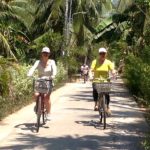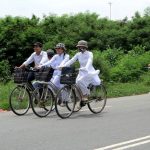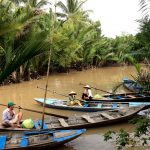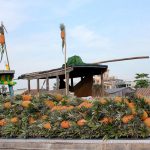Vietnam Overview:
Xin Chao Vietnam ! Welcome to Vietnam, a world where the colors are more vivid, the culture is richer, and the history more compelling than many other nations in the region.
Shaped like an elongated ‘S’, Vietnam stretches along the east coast of the Indochinese Peninsula and is likened by its people to a long bamboo pole hung with two baskets of rice, represented by the two fertile regions at either end of the country. Between the lush Red River Delta and the highlands in the north, known for their magnificent scenery and colorful hill tribes, and the agricultural plains and floating markets of the Mekong Delta in the south, lie miles of white sandy beaches, towering mountains, rivers and dense forests, and the thousands of bizarre rock and cave formations on the islands of the natural wonder of Halong Bay.
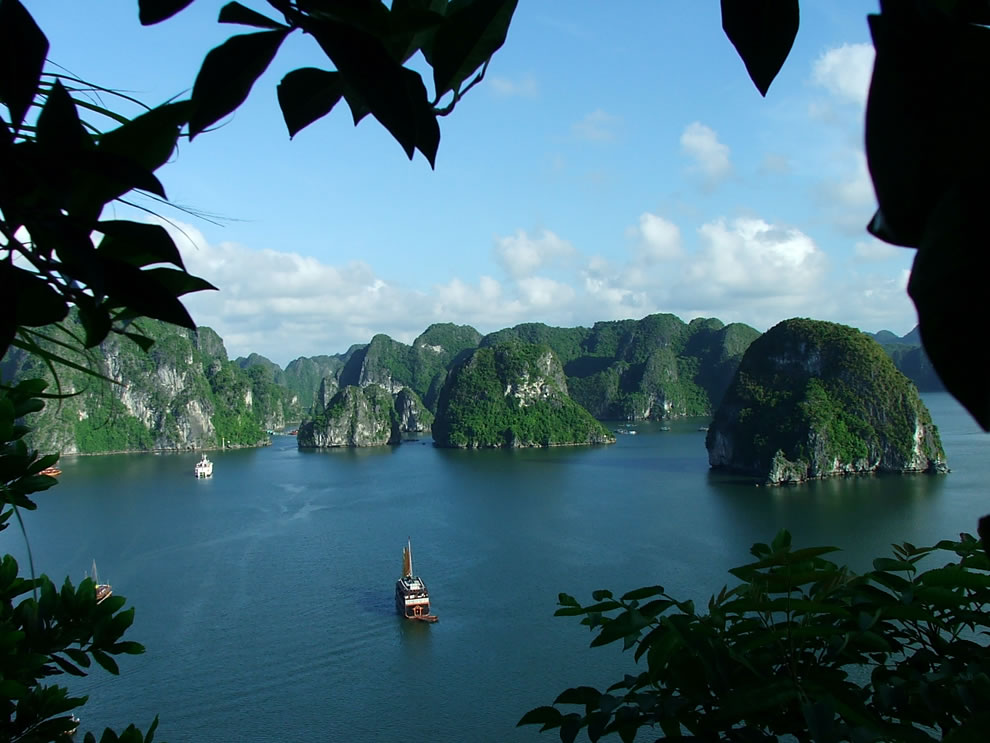
Once known as a war-torn country with everlasting and bitter civil wars and wars against the outside forces. Millions tons of bombs dropped taken millions lives, it is hard to believe that Vietnamese have regrouped, recovered, rebuilt the country, forgotten the past and moved forward to the stage as it is today. And it is even harder to deny that Vietnam has emerged as a very popular, welcoming, safe and inexpensive destination for travelers across the world.
With over 3,000 kilometers of coastline, Vietnam offers travelers a huge variety of fascinating sites, ethnic minorities, regional delicacies and renowned beauty. From the rice terraced hills of Sapa to the bustling Old Quarter and ambient French District of Hanoi and further to the spectacular and unique scenery of Ha Long Bay, from historic Hue to charming Hoi An, from the azure beaches of Nha Trang to the rolling countryside of the Central Highlands, from the manic pace of Saigon (Ho Chi Minh City) to the lazy rhythms of the Mekong River – Vietnam and its friendly and hospitable people have a wealth of fabulous travel opportunities that will amaze and inspire any visitor again and again.
Before you go:
1.Visa & Custom Procedures:
As soon as you arrive at the airport in Vietnam, you are required to complete an entry and exit form. This form is also used for Customs declaration. Currently, the Vietnam arrival / departure card CHY2000 is used for this procedure. Fill in and mark (x) in the appropriate box from No.1 to No.16 of the declaration form before submitting it to Customs, Immigration and Public Health authorities.
In cases of re-entry or re-exit without any must-be-declared items, you simply present your declaration form fulfilled earlier or make a new one, if necessary.
Regular Visa
A normal 30 day-stay and single entry tourist visa allows visitors to enter and exit Vietnam at Hanoi, Saigon and Da Nang airports airports or at any of its land borders to Cambodia, China and Laos. Processing a tourist-visa application typically takes four or five working days in U.S, Australia and most of other European countries. For most of the case, visitors can always extend their visa for one more month while in Vietnam. However, some Southeast Asian countries including Thailand, Philippines, Malaysia, Indonesia, Singapore and Laos, Cambodian are exempted from visa when entering Vietnam. Vietnam also has a visa exemption for South Korean, Japanese, Swedish, Norwegian, Danish, Beralusian and Finnish citizens. Passport holders from these countries can travel to Vietnam up to 15 days without applying for tourist visas.
New: Vietnam will offer visa exemptions for single-entry visits of up to 15 days for visitors from Germany, France, the UK, Italy, and Spain starting this 1st July 2015
Visa on Arrival
Vietnam Guiding (VG) can arrange a visa on arrival for its clients. What you need to do is to scan and forward us your passport’s details in advance and we will send you a confirmation for the visa to be issued at your airport of arrival.
Passport details and arrival and departure dates for each individual are sent by e-mail or fax to (VG) no later than 4 working days prior to departure date to Vietnam.
VG submits the details to the Immigration Office, which takes 3 working days for processing.
The Immigration Department notifies VG of the visa approval and returns an approval number to VG
VG sends a faxed copy (or email) of the approval letter to the agent or directly to the individual concerned.
The traveller or tour-group operator must show these visa approval codes at the airline check-in counter before flying to Vietnam.
Upon arrival, the group or individual will need to go to “LANDING VISA” counter where their visa will be processed. They need to fill in a form (photo required) and get the visa stamped by Immigration Officer.
The visa gets stamped in the passport.
A three-month multiple-entry visa allows visitors to spend more than a month in Vietnam, exit Vietnam and enter again. This visa may cost up to almost US$100 and may not be available at Vietnamese Embassies.
Re-Entry Visas
It’s possible to enter Thailand,Cambodia or Laos from Vietnam and then re-enter without having to apply for another visa. However, you must apply for a re-entry visa before you leave Vietnam. If you do not have a re-entry visa, you will have to go through the whole visa process again.
Re-entry visas are easiest to arrange in Hanoi or Saigon, VG can arrange this for its clients at the cost of around US$ 25, and the process may take up to 03 working
Visa Extensions
VG can help extend Tourist-visa up to a month at the cost of around US$20 and the process may take up to 4 or 5 working days. Also, tourists can always extend their own visa in major cities, such as Saigon, Ha Noi, Da Nang and Hue at the cost of around US$10
Airport Tax
Airport tax already included in the air ticket effective from 1 November 2006.
BORDER CROSSING TO CAMBODIA, LAOS AND CHINA
To Cambodia
There are Three border crossings to Cambodia:
MOC BAI:
The main overland border crossing to Cambodia is northwest of Ho Chi Minh City at Moc Bai. The trip from Ho Chi Minh City to Phnom Penh take around eight hours.
VINH XUONG:
A new riverside border crossing is located 30kms north of Chau Doc, in the Mekong Delta at Vinh Xuong. From here you can take boat transfers up the Mekong River to Phnom Penh.
XA XIA
A newest border gate operated at Xa Xia, just 1km from HaTien town, Kien Giang Province of Mekong delta.
To China
There are three border crossings over to China:
LAO CAI:
The Hekou Bridge overland border to China is at Lao Cai, (the main train station for Sapa) in the northwest. Twice weekly trains also run from Hanoi to Kunming in China; you can also board the train at Lao Cai Train Station.
MONG CAI:
The Mong Cai overland border crossing to China is in the northeast. To get there, you can get hydrofoils direct from Hai Phong or Ha Long.
HUU NGHI:
Huu Nghi is an overland border 18kms north of Lang Son, in the northeast. There are also local trains from Hanoi, which stop at Dong Dang Station, 4kms away from Huu Nghi. The international train for China (Beijing) departs Hanoi’s main train station via Dong Dang Station, but you can only join the train at Hanoi.
To Laos
There are two border crossings to Laos:
CAU TREO:
Vehicles can access this border to Vientiane. The border is near Vinh City in Vietnam’s Central Provinces.
LAO BAO:
From Hue, this border is a good connection for traveling to Savannakhet. The border is near Dong Ha in the Central Provinces
2. Weather:
The answer of best time for visitors to travel to Vietnam is a tough call! Vietnam spans several climatic zones, resulting in substantial weather condition variations between the north and the south. Average temperatures year-round range from 20 to 35 degrees Celsius. Therefore, there is no particularly good or bad time to visit Vietnam.
In Southern Vietnam tropical conditions prevail, and there are two seasons – the wet season lasts from May to November and the dry season from December to April. The wet is characterised by high humidity levels and a refreshing afternoon downpour. Humidity in the south during the months of June and July ranges between 75% and 85%. The hottest months are from March to May.
Central Vietnam is usually dry from May to October and wet from December to February. October and November occasionally see unstable weather conditions and flooding.
Northern Vietnam also experiences two seasons, though conditions can change dramatically throughout the day. The winter months from November to April are usually cold and humid. The months of December and January can be particularly cool with temperatures as low as 8 degrees Celsius. Temperatures can drop to 0 degrees Celsius in Sapa (in the highlands near the Chinese border) in winter. Summer, from May to October, can be quite hot and wet with regular downpours and occasional typhoons. The hottest months are July and August.
January or February witness Vietnam’s biggest and lengthiest festival in the calendar- that is Tet. Some travellers like to time a visit with Tet (Vietnamese New Year), it’s a nice idea in principle, but not in practice, as the whole country is on the move and prices rise dramatically. Transport is crammed in the runup and aftermath, the Reunification Express shuts down during festivities, and most shops and businesses are closed for the best part of a week.
3. What to Pack and Clothing:
Air tickets: check your departure time and date. Where possible buy e-tickets it saves you time when you inadvertently lose the document you can always pull out a copy from the computer or provide the ticket number. Paper tickets are more likely to get lost and end up having to wait for months to claim the lost ticket. Make sure you save a copy of your e-ticket in your traveling email.
Call your credit card company to inform them you will be traveling overseas and name of countries that the card will charged and the period that you will be using the card overseas to avoid identity theft and inconvenience that your card gets blocked when you travel.
Check your visa documents and passport photos if you need them to get visa on arrival.
Make some copies of your passport and visas scan and email them to VG in case
Make sure you have your health insurance with you and send us a copy prior to your departure
Check with your mobile phone provider if they have roaming coverage in the Vietnam and other countries you are traveling. Make sure your phone is compatible to receive or make calls in the country you will be traveling. Sometimes it’s cheaper to buy a local SIM card in the country of arrival and put it in your phone to use locally. But it’s always good to have a back up to have your phone roaming coverage.
Make sure you have enough passport pages in your passport. Usually try to have at least 2 pages in your passport for each country you will be visiting (not transiting at the airports). This is if you will get your visa on arrival at the country you are visiting.
Please note down VG’s 24/7 number and mobile phone number in your phone or diary note
Pack medications in their original, clearly labelled, containers. A signed and dated letter from your physician describing your medical conditions and medications, including generic names, is also a good idea. If carrying syringes or needles, be sure to have a physician’s letter documenting their medical necessity. If you have a heart condition bring a copy of your ECG taken just prior to travelling. If you happen to take any regular medication bring double your needs in case of loss or theft. In most Southeast Asian countries you can buy many medications over the counter without a doctor’s prescription, but it can be difficult to find some of the newer drugs, particularly the latest antidepressant drugs, blood pressure medications and contraceptive pills.
Light and cotton clothes are highly recommended as the weather is warm and humid, or cool most of the time. If you are travelling to Vietnam around or after Christmas, please bring along some light sweaters as it may be a bit cold in the north
4. Food & Drinks:
Not so long after landing in Vietnam and you’ll realize how few of its gastronomic specialties see the light of day beyond its borders. Every region lays claim to unique edible delights – well-known classics such as northern Phở (meaty rice-noodle soup), Hue imperial banquet fare (Bánh), and southern salad rolls (Gỏi Cuốn) are just the tip of the culinary iceberg. Vietnamese cuisine is fresh and tasty and one of the many highlights of a visit to the country, and the diversity of options is just astounding. Beside the fantastic local dishes, the option to go to back-home dishes is rather easy in most major cities. Vegetarians are well-looked-after in Vietnam. If you want dig deeper, try some of the country’s best;
Bún Riêu Cua ( Crab meat noodle soup )
This crustacean-flavoured soup is very popular in the north and northern regions. It’s made from paddy crabs, packed with tomato chunks, green onions and bun (fine, soft and fresh rice-vermicelli), and capped with a floater of sautéed crab fat. Some cooks add bean curd and ốc (large snails, in which case the dish is called bún riêu cua, ốc). Green leaves and herbs, along with sliced banana tree stem, are mainstay accompaniments.
Bánh Tráng Phơi Sương ( Dried Rice papaer )
A stunning southern dish originated from Trang Bang District, Tay Ninh Province. This is a do-it-yourself roll. The roll is a combination of veritable hedgerow of unusual greens and herbs, many of which are gathered wild from riverbanks and rice paddies, and thinly sliced pork and cucumber, accompanied by pickled garlic, daikon and carrots. Everything’s bundled into rustic rice papers, which have, as the name of the dish suggests, been ‘exposed in the dew at night’, and dipped in nuoc cham (light version of fish-sauce)
Canh Chua ( sour soup)
This beautiful, tangy tamarind-flavoured soup embodies the Mekong Delta’s abundance: from its waterways come fish; from its fruit plantations, pineapple; and from its fertile soil, tomato and spongy bac ha or taro stem. The region’s rice paddies contribute the cuminlike herb. Accompanied by rice it’s an unpretentious yet appetising meal in a bowl. Locals usually serve this soup with clay-pot -salty-cooked fish or pork. That really completes the Ying and Yang eatery academic!
Drinks
Tea
Northerners tend to enjoy tea more than people in other regions. Green tea is refreshing and available everywhere. Lotus tea is an important ritual and very popular during Tet
Coffee:
Vietnamese males seem to drink much more coffee than females. It is usually the case that fresh and filtered coffee is served at the table in front of customers (with a peculator on top of a cup). The coffee is very strong and in most of the cases combined with sweeten-condense milk or sugar, and even ice
Rice liquor and sticky-rice liquor
There going-down-very-hard locally distilled are the local favorite throughout the country. Watch out! They are generally extremely potent.
Beer
Local beers, Saigon beer, 333, Hanoi beer, Huda beer, are highly recommended. Bia Hoi (local draught beer available at street stalls everywhere, particularly in Hanoi. It is not only cheap, but free of additives). Interestingly, locals refer to drink beer with ice rather than cold beer! You can almost get all imported international beer brands in Vietnam these days
Nightlife
Vietnam definitely cannot match Thailand when it comes to the nightlife, but Saigon has a vast range of bars, clubs, live music venues and restaurants from gloomy little establishments to some rather upmarket venues. Hanoi’s nightlife is on the up, and there is an increasingly good selection of bars and restaurants, although the city can still seem a little quiet after 10pm. However, some after-hours bars can be found on the sly. Elsewhere there are bars and restaurants but the choice is limited. There is never any entrance fee to bars, but nightclubs generally charge around US$5. The dress code is very relaxed with no restrictions on jeans or trainers. Gambling is illegal in Vietnam for the Vietnamese but is allowed by foreign passport holders. Check with your local guides for the trendiest ones in town!
5. Money/Internet/Electricity
Money
The official unit of currency in Vietnam is the dong (VND)
Money Notes & Coins
The first currency of Vietnam is the dong, which is abbreviated to ‘d’. Banknotes come in denominations of 500d, 1000d, 2000d, 5000d, 10,000d, 20,000d, 50,000d, 100,000d, 200,000d and 500,000d. Coins are also in circulation, although they are more common in the cities, and include 500d, 1000d, 2000d and 5000d. Currently (Feb, 2010), it is around 20,800d to US$ 1.
ATMs
These days, ATMs can be found in all major cities and every province’s capital cities. Vietcombank has the best network in the country, including most of the major tourist destinations and all the big cities. Agribank, Vietin Bank, Techcombank and Sacombank are also well represented. Every branch stocks a useful leaflet with a list of their nationwide ATMs. Withdrawals are issued in dong, and there is a single withdrawal limit of 2,000,000d (about US$125). However, you can do multiple withdrawals until you hit your daily limit. ANZ offers 4,000,000d withdrawals per transaction. Most banks charge 20,000d per transaction.
Cash
Most major currencies can be exchanged at leading banks in Vietnam, but away from the tourist centers the US-dollar remains king. Vietcombank and Sacombank are the most organized of the local banks for changing cash and can deal with euros, pounds and pretty much anything else you are packing. Changing US$100 will make you an instant millionaire! It’s a good idea to check that any big dollar bills you take do not have any small tears or look too tatty, as no-one will accept them in Vietnam. You cannot legally take dong out of Vietnam but you can reconvert reasonable amounts of it into US dollars on departure. Most land border crossings now have some sort of official currency exchange, offering the best rates available in these remote parts of the country.
Credit Cards
Visa, MasterCard and JCB cards are now widely accepted in all major cities and many tourist centers. However, a 3% commission charge on every transaction is pretty common; check first, as some charge higher commissions than others. Some merchants also accept Amex, but the surcharge is typically 4%. If you wish to obtain a cash advance from Visa, MasterCard and JCB, this is possible at Vietcombank branches in most cities, as well as at some foreign banks in Saigon and Hanoi. Banks generally charge a 3% commission for this service. This is handy if you want to take out large sums, as the ATMs have low daily limits.
Travellers Cheques
It is wise not to rely entirely on travellers cheques by keeping a reasonable stash of US dollars to hand. Travellers cheques can only be exchanged at authorised foreign-exchange banks, but these aren’t found throughout Vietnam. If you only have travellers cheques, stock up on US dollars at a bank, which will usually charge anywhere from 0.5% to 2% commission to change them into cash. Vietcombank charges no commission for exchanging Amex travellers cheques; a reasonable 0.5% for other types. If your travellers cheques are in currencies other than US dollars, they may be useless beyond the major cities. Hefty commissions are the norm if they can be exchanged at all.
Internet
Vietnam may be on top of the list of developing countries, even better than China, where internet access is very easy and at reasonable cost. Most standard hotels offer free internet access at the lobby, upmarket hotels may have some kind of different cost. WIFI can be found in most hotels and upmarket cafes. And street internet-access can be found even in some remote towns!
Electricity
Throughout the country, you can only get 220 volts electricity source. Some upmarket hotels may offer some sort of adaptor for its in-need clients
6. Shopping & Tipping:
Shopping:
Vietnam is fast becoming known as a “shopper’s paradise.” Ceramics, lacquerware, silk and embroidery are just some of the good buys on offer. Many travelers also have clothes tailored due to the low prices. Hanoi’s Old Quarter is particularly excellent for visitors, with shops selling clothes, gold, embroidered tablecloths and handbags. Markets are always great places to enjoy the local flavour and buy souvenirs. Silk goods are particularly prominent; however the quality can differ vastly. Hoi An seems to be the right place for visitors who want to have their clothes tailored. Ben Thanh market in Saigon and Dong Xuan market in Hanoi are worth a visit. The hill tribes of the Central Highlands and the north of the country now sell colorful woven bags and clothing, often from cooperatives of women workers.
Some bargaining is essential in most tourist transactions and local markets. In some cases you will be able to get a 50% discount or more, at other times this may only be 10%. And once the money is accepted, the deal is done. Don’t waste time getting stressed if you find out someone else got it for less; it is about paying the price that is right for you, not always the local price.
Shopping hours: Daily 0800-2100(approximately).
Tipping
Tipping is now quite customary in Vietnam. If you are happy with the services provided by your guides and drivers, a tip is appropriate. While it may not be customary in all cultures, tipping inspires great service, and is an entrenched feature of the tourism industry across destinations. As a general guide in these destinations, if you travel on our group tour, please allow US$ 3 to US$ 4 per day per traveler for each of your local guide and driver. If your tour is private, please allow around US$ 6 per day per traveler for each of your local guide and driver. Of course you are free to tip more or less as you see fit, depending on your perception of service quality and the length of your trip. Should you be dissatisfied with the services provided by your local guide or driver please let us know.
7. Dangers & Annoyances:
Crossing The street:
As you cross the street DO NOT STEP BACK while you are in the middle of the street move forward and do not make sudden moves.
Looking at some local crossing and walk along side with them.
Just stop infont of big bus/car/ truck….not by moped they will manage to go round you
Beggar
Vietnam is still a developing country; visitors can expect to encounter beggars at tourist spots, markets and streets. One way to contribute and help improve the situation is to invest just a few hours to find out about local organizations that work with disadvantaged people; these groups are far more likely to make sure contributions are used in the most effective way possible to help those who need it. V.G works with local communities to run meaningful project-works in rural areas and cities. We are more than happy to assist our clients who want to help local communities
Scams
Con artists and thieves are always seeking new tricks to separate naive tourists from their money and are becoming savvier in their ways. The most common scam most visitors encounter is the oldest in the book. The hotel or restaurant of choice is ‘closed’ or ‘full’, but the helpful taxi driver will take you somewhere else. Pre-book your hotel, restaurant or email in advance and stop the scammers in their tracks.
Theft
Street crime is commonplace in Saigon, Nha Trang and on the rise in Hanoi, so it doesn’t hurt to keep the antennae up wherever you are. Don’t have anything dangling from your body that you are not ready to part with, including bags and jewellery, which might tempt a robber. Keep an eye out for the Saigon cowboys – drive-by thieves on motorbikes – they specialise in snatching handbags and cameras from tourists on foot and taking cyclos (pedicabs) in the city. Pickpocketing did occur in the tourist areas of Saigon and some other major cities Despite all this, don’t be overly paranoid. Although crime certainly exists and you need to be aware of it, theft in Vietnam does not seem to be any worse than what you’d expect anywhere else in the world. Vietnam remains one of the very safe destinations in Asia


